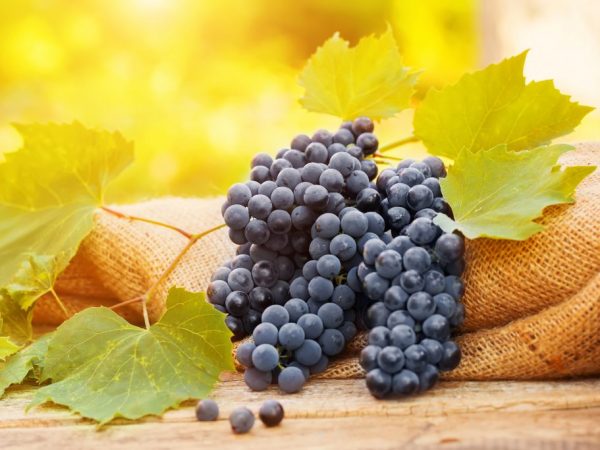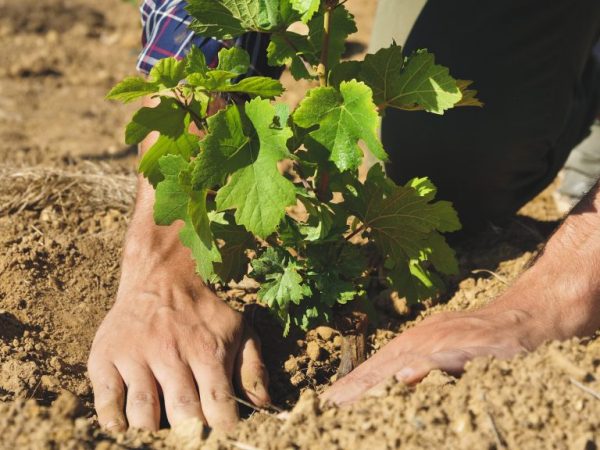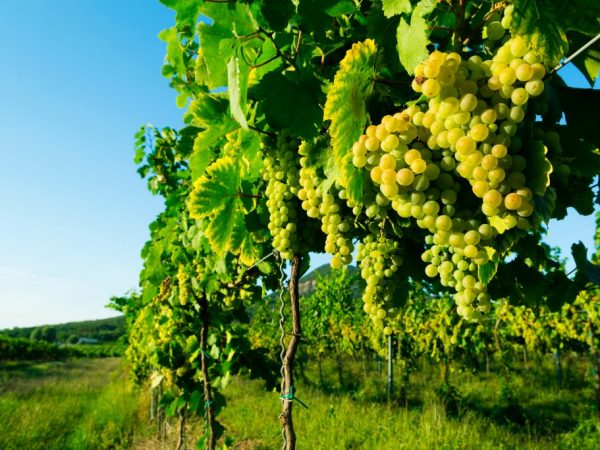Growing grapes in Siberia
Grapes are a thermophilic plant. Its cultivation is a lot of difficulties. Years of practice and breeding research made it possible to grow grapes in Siberia and get a full harvest.

Growing grapes in Siberia
Features of viticulture in Siberia
The cultivation of grapes in Siberia is carried out according to 2 schemes. First rules:
- storage of seedlings is carried out in protected, frost-free buildings;
- planting pits are deeper than in the southern regions, with the exception of soils with a high groundwater occurrence;
- the garter is carried out with the onset of stable heat: at the time of frost, the bushes are covered with rags;
- in summer, minimize garter and shaping;
- exclude feeding and treatment with fungicides: there are no pests in cold regions, and the culture is protected from diseases by removing weeds and fulfilling elementary agrotechnical requirements;
- the formation of a bush of a heart-ray shape is carried out on a vertically located wire trellis;
- the increase in pressure on the buds and branches during pruning is made 2 times higher compared to that inherent in the southern technique.
The second system does not involve grafting for frost-resistant varieties. Chubuki of the required length is prepared in the fall and stored in the basement or with a covered parent specimen. Planting holes are not dug on chernozem soils. Loosening, fertilization, fungicide treatment are excluded. Pruning is carried out once a season, before preparing for the winter.
Types of grapes for Siberia
The primary task is to select a hardy grape variety for Siberia. The southeastern exotic will freeze out in winter. Through trial and error, winter-hardy species have been selected that can adapt to abnormal cold weather. In Siberia, very early grape varieties are used: Valiant, Golden Key, Muscat, Amur, Kaya, Venus.
Mid-season species: White Savraska, Muromets, Alpha, Delight. Late-ripening varieties: Obskoy, Reline pink, Biysk-2, Lando Noir.
Seedlings are bought in specialized stores. When buying, the cuttings are examined for mechanical damage. The condition of the root system is assessed.
Disembarkation
Grapes in Siberia will not take root in the low-lying area, the northern hill, blown by the winds. It is better to plant the shanks in the southeast, or south of the site.
Grapes are planted in Siberia from north to south in order to ensure optimal uniform illumination of the sun from 2 sides.
It is better to find a place next to the outbuildings that protect the plants from the wind from the west. They refuse to plant grapes in swampy and high groundwater areas.
A large vineyard is planned in advance. To ensure good ventilation and illumination, a distance of 2.5-3 m is left between the rows.
Disembarkation dates

It is recommended to plant the plants at the end of May.
Grapes in Siberia take much longer to take root. The root system develops much more slowly than in the south.Vineyards in cold climates begin to be planted after the establishment of a stable high temperature of at least 15 ° C.
The disembarkation time falls on the 2nd part of May. Landing is carried out on a cloudy quiet day or a calm evening. The bright sun will weaken the plants, and they will not take root well in the open field.
Preparation of seedlings
It will not work to grow grapes from seeds in Siberia. The plant will not be able to adopt maternal qualities, it will be weak and is unlikely to give full-fledged fruits. It is better to grow seedlings growing in peat glasses, or cuttings that have wintered for a year in a dry, frost-protected basement.
Preparation of grape seedlings in Siberia:
- the roots are cut to 10-12 cm;
- the vine is shortened to 2 buds;
- rhizomes are soaked in heteroaunsin or sodium humate, in accordance with the manufacturer's description;
- rhizomes are treated with a chatterbox made of clay and ash, planted.
Landing technology
How to properly plant grapes in Siberia:
- the depth of the hole is 1 m, the width corresponds to the dimensions of the rhizome;
- a layer of gravel is poured onto the bottom;
- install a plastic tube to ensure good aeration of the soil.
Part of the upper earth, dug out of the hole, is mixed with sand, organic matter, and a hill is formed on a layer of gravel. The roots are spread on a mound and sprinkled with soil. Having rammed, spill the earth with warm water.
Care
Taking care of grapes in Siberia is much easier than in the southern regions.
Grapes for Siberian conditions are distinguished by their hardiness. It is customary to grow it using toughened technology. The seedlings are not fed. The main agricultural activity is pruning.

Plants are not difficult to grow
For 1 year of life, 2 powerful shoots are left on the plant. If the sprout originally had 2 shoots, the vine is shortened by 1 bud. The sprouting shoots are pinched on the stump. If the seedling contained 1 shoot, when it reaches a height of 60 cm, pinch the growth point to allow lateral branches to develop.
Pruning
Growing grapes in Siberia is not difficult for novice winegrowers. The main thing is to correctly form a bush in order to ensure full development of fruiting shoots. The first pruning is carried out in late August and early September. Remove dry, damaged, weakened, fertile vine.
The second is done before preparing for the winter. To plant full-fledged grapes in Siberia, the second formation cannot be tolerated in the spring. The purpose of the procedure is to remove new fruiting shoots as the main ones. Leave 2 strong, adjacent sprouts with 10-20 eyes. The girlish is cut off, the man's is left long. In the summer, the maiden will form a crop, in the second - the shoots.
In the fall, the sequence of actions is changed. The maiden shoot is left long, the male shoot is cut on a stump. The process allows you to rejuvenate the bush and prevents the crown from thickening.
Load on plants
The vineyard in Siberia should not be overloaded. This is an important agrotechnical move that allows you to get a consistently high yield. The load is determined by the number of buds on the shoot, which subsequently give flowers. An increase in load reduces the quality of the crop, weakens the plant, a decrease - accelerates the growth of the deciduous part. Weak plants freeze and die in winter.
Early grapes for the conditions of Siberia for the first 2 seasons strengthens the rhizome, adapts in the open field. In the first fruitful year, 20 buds are left on the plant, in the second - 40, in the third - 60, in the fourth - 80. An adult vineyard includes plants with 150 eyes on each. The indicator is averaged. The orientation according to the load norms is reduced to the peculiarities of the variety: small-berry ones load more, large-berry ones - less.
Hardening
Care in Siberian conditions involves the adaptation of plants to the harsh climate. Plants are planted in open ground. Greenhouse shelters are not built.An exception to the rule that allows the construction of a temporary greenhouse: spring frosts occurred in the first winter of the plants on the site, and the shoots have not yet reached the growing point that allows them to be attached to the trellises.
Hardening allows you to accelerate acclimatization. Plants become more resistant to temperature extremes. Regular overexposure in the shelter will pamper the bushes. Covered specimens produce crops and tolerate the season well, but freeze in winter.
Winter shelter
You need to take special care of the grapes in the pre-winter period. Preparation begins when the average temperature indicator per day approaches 0 ° C. At the time of organizing the shelter, the bushes are already cut off. The vine is removed from the fasteners and bent to the ground along a previously dug trench. The plant is carefully examined: it must be completely dry.
The vine is covered with rags, sprinkled with earth and covered with spruce branches. Grape bushes are sprinkled with fallen snow. The upper shelter is removed after its descent. The rags are removed during the activation of sap flow processes (in April). For shelter from night frosts, grapes are covered more easily.
Summarizing
Growing grapes in Siberia is affordable thanks to years of hard work on agrotechnical techniques. Correct planting and minimal maintenance allow you to get high-quality crops that are not inferior in quality to the products of the south.
The cultivation of grapes in Siberia has its own characteristics and requires a thorough approach to the choice of varieties. It is better to grow early varieties on the site: such plants have more time to harvest nutrients for winter.


